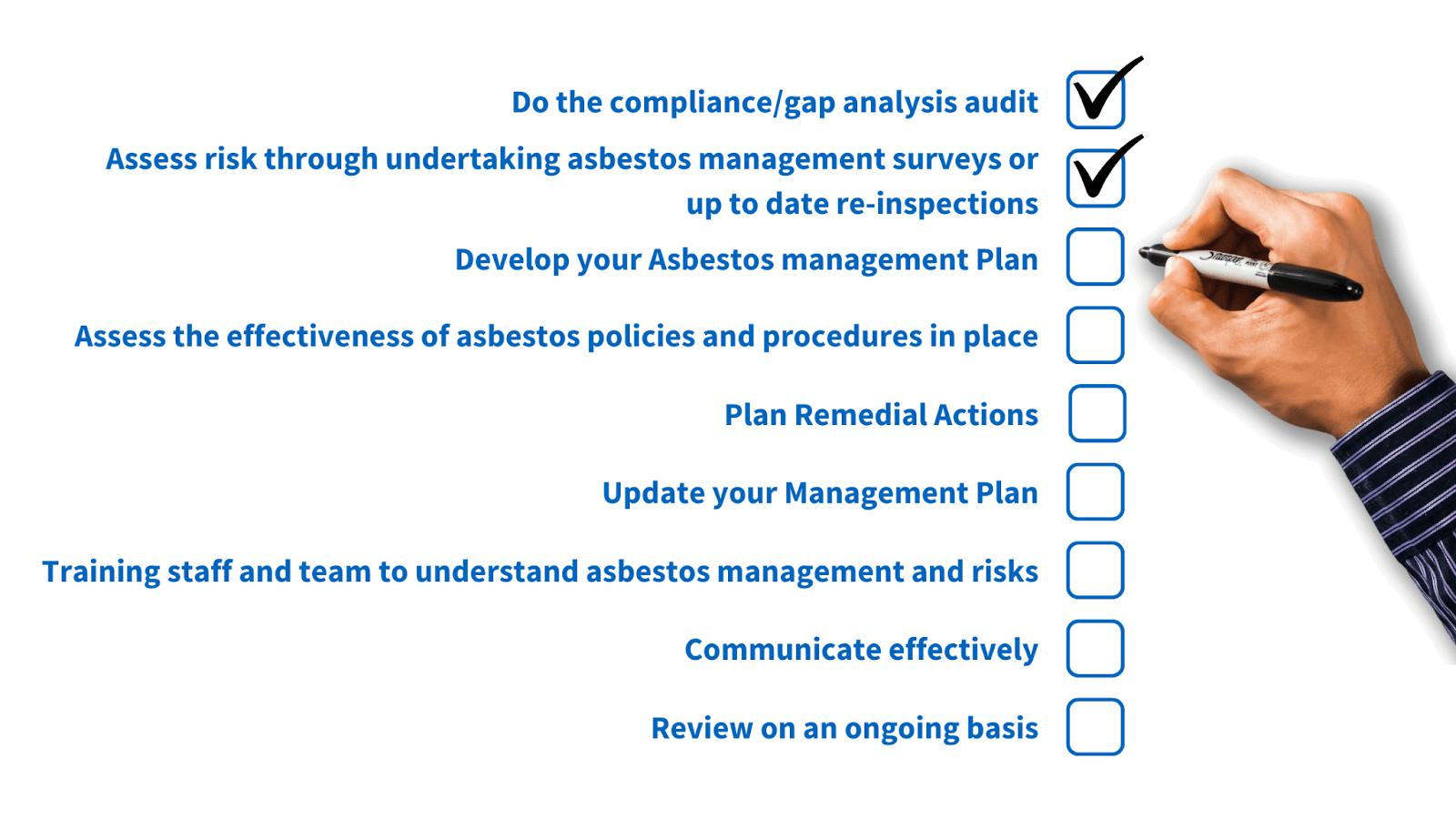Protecting people and planet
Protecting people and planet
Protecting people and planet
Protecting people and planet
Protecting people and planet
Have you set your Asbestos Compliance Goals for 2024?

Lucion Group
1st January, 2024

Head of Group Commercial, Kim Johnson shares a checklist of things to consider on your journey to asbestos compliance and what to include when planning your 2024 Asbestos goals.
Lucion’s purpose as a responsible business is to protect people and the planet, which we manifest through our expertise in hazardous materials risk management, and deliver as trusted advisors to our clients by facilitating and supporting their compliance requirements.
Effectively managing environmental risks is imperative to protecting your building occupants, and organisation from the risks of asbestos and other hazardous materials.
If you have the responsibility for the safe management of asbestos then it's important to be aware of the responsibilities and actions required to achieve compliance within your organisation.
Managing risks associated with asbestos relies on expert inspection and testing services, the development of an adequate management plan, audits, appropriate training and communication.
Below I've provided a checklist of the important steps to take on your Asbestos compliance journey, if your 2024 Asbestos goals don't include all these areas it may be time to seek expert advice.

Need help in achieving your compliance goals?
Here at Lucion, we help you achieve your compliance goals and provide a trusted partnership with you and your organisation.
Get in touch with us by submitting an enquiry online at contact form or email info@lucionservices.com
Do the Compliance/Gap Analysis audit
While duty holders must strive to ensure that they constantly have an up-to-date asbestos management plan in place, they must also determine whether the policies and procedures that form part of this plan are adequate.
Asbestos management system reviews/audits/gap analysis reviews existing systems and information to assess whether compliant or if not, what recommendations need to be made to achieve an acceptable standard of compliance.
Such an audit can assist in identifying whether each element of a duty holder’s asbestos management is effective and fully compliant with the Control of Asbestos Regulations 2012 (CAR 2012) and other relevant health and safety legislation/guidance.
There are several key areas of legislation within CAR 2012 that a duty holder will need to comply with for their policies and procedures to be deemed suitable and sufficient, including (but not limited to):
-
Regulation 4 - duty to manage asbestos in non-domestic premises
-
Regulation 5 - identification of the presence of asbestos
-
Regulation 10 - information, instruction and training
-
Regulation 15 - arrangements to deal with accidents, incidents and emergencies
-
Regulation 16 - duty to prevent the spread of asbestos
Assess risk through undertaking asbestos management surveys or up-to-date re-inspections
The asbestos management survey is a legal requirement for duty holders responsible for any non-domestic premises. This asbestos survey is a surface sampling survey, designed to identify all of the materials that could potentially be disturbed during normal occupancy of the building and will take into consideration the contextual use of the building i.e. if there is a lot of moving traffic from the building occupants such as in a retail building.
Asbestos management surveys will identify any asbestos-containing materials, their location and their condition. It will take into consideration light maintenance work (ie. changing light bulbs, checking above lowered suspended ceiling tiles, loft spaces, etc) but it is not a destructive/intrusive survey.
Should asbestos-containing materials be identified in your asbestos management survey report, our asbestos project management team can help you choose and plan your next course of action to achieve compliance:
- Asbestos Removal
- Managing Asbestos In Situ
An asbestos re-inspection survey allows the duty holder to monitor and record the condition of any previously identified asbestos products within a building.
Like any building material, asbestos-containing materials are also subject to potential damage and degradation. As an asbestos product degrades it can be more likely to become a hazard to health, therefore should be inspected at regular intervals to ensure its condition has not deteriorated.
For this type of survey to be undertaken, an existing asbestos survey or asbestos register should be in place.
Develop your Asbestos Management Plan
Asbestos Management Plans (AMP) provide details of how the asbestos within buildings, identified or presumed, is to be managed after an Asbestos Survey has been conducted. It includes:
- Who the Duty Holder is
- Details of the Asbestos Register
- Action Plan
- Training Schedule
- Communication Strategies
- Contingency Plan
- Emergency Arrangements
You can find out more information about what should be in your asbestos management plan in our Asbestos Management Plans Guide.
Assess the effectiveness of asbestos policies and procedures in place
When determining the adequacy of asbestos management procedures and policies, a number of areas will need to be assessed and reviewed accordingly. Examples of questions that will be asked as part of a compliance audit include:
- Who is responsible for the management of asbestos on the premises?
- How frequently are asbestos management policies and procedures reviewed? Is there a schedule for regular re-inspection surveys in place?
- What methods are in place to disseminate information regarding the location and condition of asbestos to all involved parties?
- Are all persons potentially liable to disturb ACMs adequately trained (including regular refresher training)? How competent and experienced is the individual providing the training?
- Is there an accident and emergency procedure for asbestos-related incidents in place? How is this communicated? How and when is this reviewed? (Click here to access the HSE’s infographic on how duty holders can ensure they have an effective accident and emergency procedure in place.)
Plan Remedial Actions
It’s not always necessary to remove asbestos. It can be managed safely in situ. If the ACM is low-risk, or it can be isolated and kept safe from damage, then this could be the best option. This is only the case so long as deterioration or disturbance does not occur; hence the need for asbestos re-inspections.
Update your Management Plan
Asbestos management plans must be updated periodically, particularly if there have been any significant alterations to the property or its usage, or if there is a reason to suspect that the management plan is no longer valid (such as in the event of an accidental asbestos release or a change in legislation and/or recommended guidance). The plans must also be updated whenever work has been carried out on the premises that may affect ACMs, while also checking their condition regularly to make sure they haven’t deteriorated during this time and pose a higher level of risk to those occupying the premises. It is also essential that those responsible for the identification and management of ACMs are noted as the relevant points of contact on the asbestos register. Additional details, such as when these individuals last received asbestos training and when their training requires updating, should also be included where possible.
Training staff and team to understand asbestos management and risks
Training needs analysis identifies different categories of employees based on their roles and responsibilities and proposes suitable training courses that meet their needs. Tailored training aids and courses improve delegate participation and understanding in the context of existing site procedures that they are already accustomed to.
The range of topics covered includes surveying, analytical, remediation and consultancy, and a comprehensive understanding of the control of asbestos regulations 2012, HSE guidance and associated legislation.
- discuss the hazards associated with working with or near asbestos-containing materials (ACMs), including the effect on health
- understand the legal requirements including the duty to manage asbestos
- apply a plan to work through the logical steps to comply with legislation
- develop an appropriate asbestos management plan using practical examples
- identify where to obtain further guidance and assistance
Communicate effectively
The asbestos management plan relies heavily on the collected data and how that data is communicated with the stakeholders (surveyors, occupants, supply chain etc.).
To remain compliant, the collected data needs to be carefully managed and the resulting action to be followed through. Effectively communicating the Asbestos management plan ensures all stakeholders are aligned, and understand their individual roles and responsibilities, without ambiguity.
Review on an ongoing basis
An asbestos re-inspection survey allows the duty holder to monitor and record the condition of any previously identified asbestos products within a building.
Like any building material, asbestos-containing materials are also subject to potential damage and degradation. As an asbestos product degrades it can be more likely to become a health hazard, therefore should be inspected at regular intervals to ensure its condition has not deteriorated.
For this type of survey to be undertaken, an existing asbestos survey or asbestos register should be in place.
What will the asbestos re-inspection report show me?
Your asbestos re-inspection survey report will:
- Assess your current asbestos documentation and identify potential issues with the data or gaps.
- Re-inspect your sites and update your asbestos records, identify any changes to your asbestos-containing materials, and provide clarity of your site position through automated site geo-location and a dynamic, data-integrated floor planner.
- Review your current control measures, documentation and asbestos management plan
If you require help with achieving your compliance goals or to discuss any aspect of the Asbestos survey, testing, assessment, management, consultancy or compliance requirements, please get in touch: info@lucionservices.com.
Register for IMPACT Bulletin
Don’t miss a beat - get the latest insights and updates from Lucion straight to your inbox.























